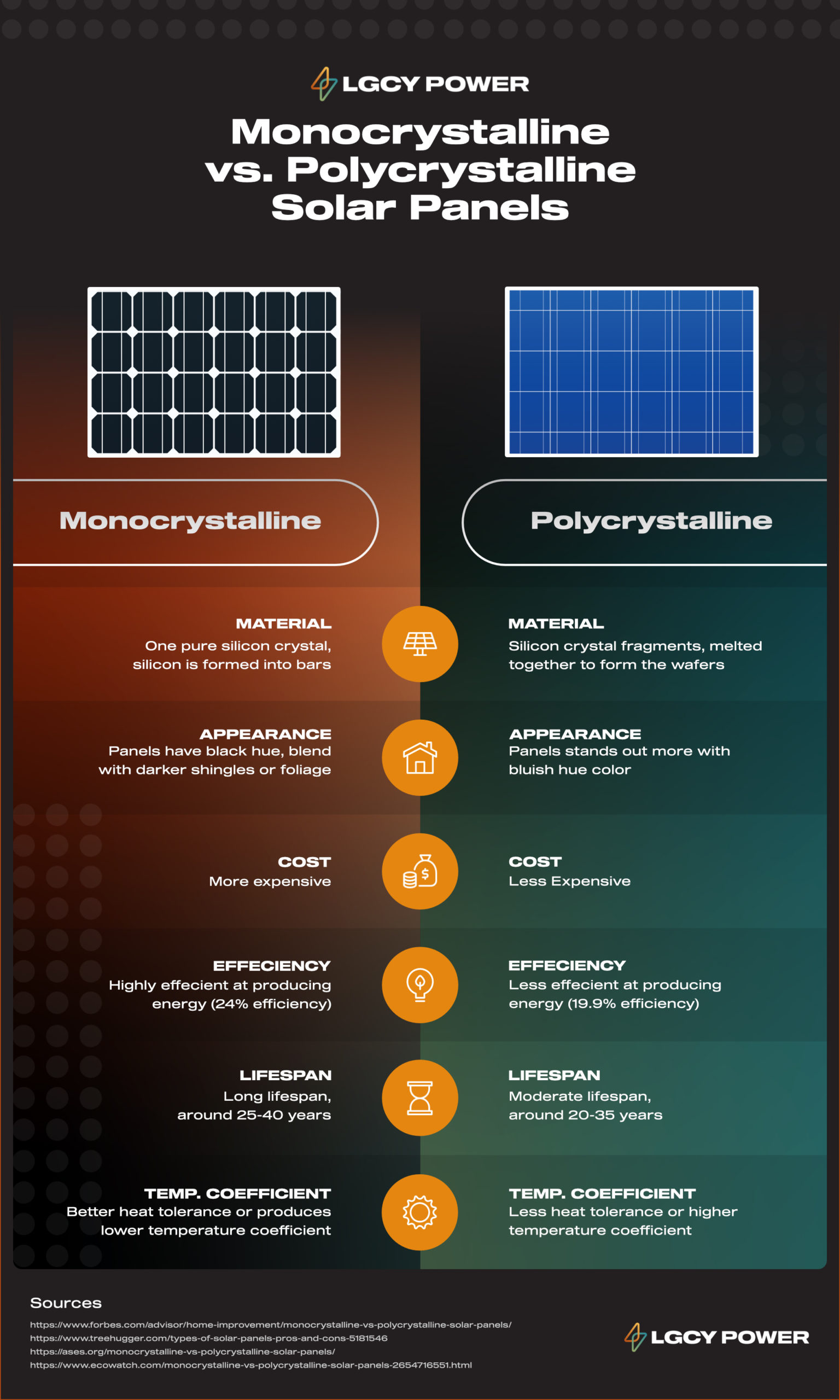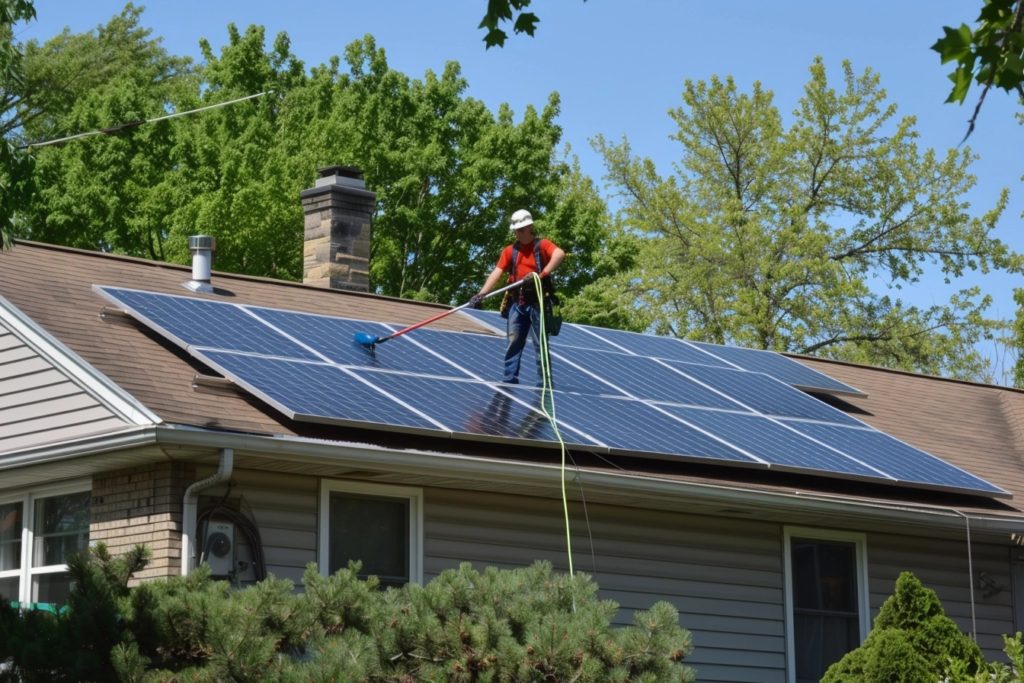
Making the decision to install a solar energy system for your home is a big first step on the road to residential energy independence. By creating energy for your own home using the sun’s rays, you’re protecting the environment while also saving lots of money compared to buying electricity from the utility company.
That said, there are other important decisions to make in this process as well. For instance, you’ll need to choose between thermal and photovoltaic solar cells, and you’ll also need to decide whether you want monocrystalline or polycrystalline solar panels.
There is a crucial difference between monocrystalline and polycrystalline solar panels, and it’s not always easy to understand. That’s why we put together this guide that breaks down the monocrystalline vs. polycrystalline solar debate into simple terms. Which is the better option for your residential solar energy array?
The Two Types of Solar Panels: Thermal and Photovoltaic
Before we dig into the competition of monocrystalline vs. polycrystalline solar panels, we first need to discuss the differences between thermal and photovoltaic panels. Thermal solar panels were invented first, and they remain an efficient energy source. A thermal solar panel concentrates the sun’s rays to create energy in the form of heat. Inside the solar panel, fluid flows through tubes.
When sunlight hits the panel, the fluid warms up, and the thermal energy can be used to heat water in a boiler. You can also use thermal solar panels to heat your home through the usage of radiant floor heaters or those in the walls, ceilings, or roof. The typical home with thermal solar energy will have storage tanks for any extra hot water.
While thermal solar panels only produce heat, photovoltaic (PV) panels generate electricity. PV solar panels don’t require large holding tanks for excess hot water. Instead, these solar panels harness the sun’s energy to produce electricity. Then, your solar inverter will convert that raw energy into a form of electricity your home can use. Any excess energy can be sold back to the grid or stored in a solar battery.
Monocrystalline vs. Polycrystalline Solar Panels
Next, it’s important to learn the difference between monocrystalline and polycrystalline solar. Every individual cell within a monocrystalline solar panel consists of one silicon crystal. On the other hand, each cell within a polycrystalline solar panel consists of many fragments of these crystals, forged together during the panel’s manufacturing process.
It’s not always easy to determine which side wins in the monocrystalline solar panels vs. polycrystalline solar panels debate, so let’s break down the differences.
Monocrystalline Solar Panel Advantages
The biggest advantage of a monocrystalline solar panel is its efficiency. Monocrystalline panels usually have efficiency ratings of around 15-20%, but some newer panels are producing even more energy than this. In fact, some experimental models are showing the capability to exceed 40% efficiency!
Another significant advantage for the monocrystalline side of the monocrystalline vs. polycrystalline solar debate is the fact that these panels are much smaller than polycrystalline panels. That means it’s easier to mount them on your rooftop. You won’t need as many of them, and smaller panels often have fewer maintenance needs as well.
Finally, monocrystalline panels tolerate heat better than polycrystalline panels. Therefore, if you’re installing a residential solar energy array in an area that regularly experiences extreme heat — such as the American Southwest — monocrystalline solar panels may be a superior option.
Polycrystalline Solar Panel Advantages
That said, polycrystalline panels have plenty of their own advantages, and there’s a reason these solar panels are still so popular. The most important advantage for many homeowners is the affordability of polycrystalline panels, and it can be a make-or-break aspect of the monocrystalline vs. polycrystalline solar debate.
A typical monocrystalline solar panel costs 20% more than a polycrystalline panel. For some homeowners, that alone is enough to tip the scales in favor of polycrystalline solar panels. Another significant aspect of the difference between monocrystalline and polycrystalline solar is how polycrystalline panels have a similar lifespan to monocrystalline panels, despite costing much less.
Even if we disregard aspects like efficiency, size, and heat sensitivity, the polycrystalline panel’s cheaper price point and comparable lifespan make it the preferred choice of many homeowners. Which side of the monocrystalline vs. polycrystalline solar panels debate are you on?
The Best Uses for Monocrystalline vs. Polycrystalline Solar Panels
To begin this section, let’s take a look at some applications in which monocrystalline solar panels are the better option. If you only have a small amount of space to work with, monocrystalline panels are a far superior choice due to their energy efficiency.
In addition, monocrystalline panels are better in two crucial geographical areas: those with less daily sunlight and those with extremely harsh sunlight. The increased efficiency of a monocrystalline panel means it can produce more energy in areas like the Pacific Northwest that don’t receive much direct sunlight. They’re also much better in desert settings, such as Arizona, due to their superior resistance to heat.
On the other side of the monocrystalline solar panels vs. polycrystalline solar panels debate, we prefer polycrystalline panels if saving money is your top priority. This is especially true when you consider that there is no meaningful difference between monocrystalline and polycrystalline solar panels regarding lifespan.
In Conclusion
We’ve covered a lot of ground in this discussion of monocrystalline vs. polycrystalline solar panels, and it wouldn’t surprise us at all if you still have some questions. If so, reach out to LGCY Power at 855.546.0851 at your convenience.
Our representatives are true experts when it comes to the difference between monocrystalline and polycrystalline solar panels, and they can help you determine which option is the best choice for your application. We can even send one of our reputable local installers to your home to perform an in-person assessment.
The monocrystalline vs. polycrystalline solar debate may never be truly settled, as both sides have their advantages and disadvantages. By properly analyzing which type of solar panel is best suited for your home, you can set up the residential solar power system of your dreams and end your reliance on traditional utility companies!





